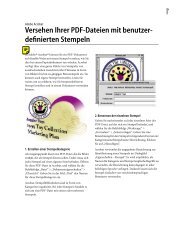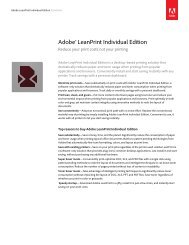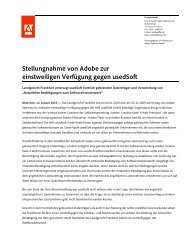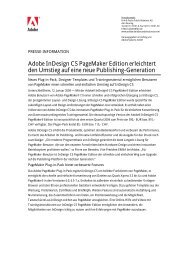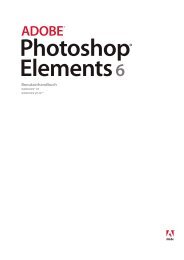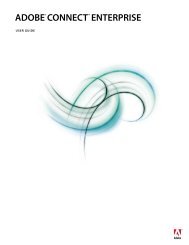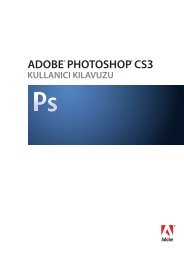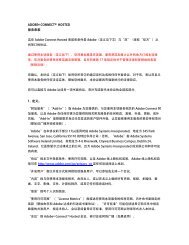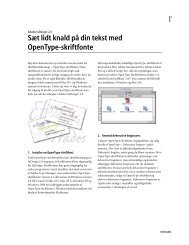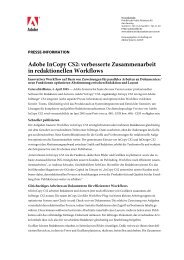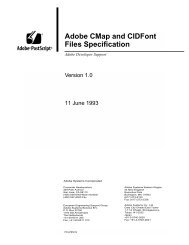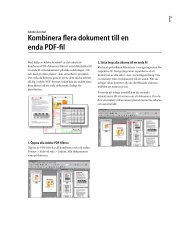Record and mix multiple tracks with a standard sound card - Adobe
Record and mix multiple tracks with a standard sound card - Adobe
Record and mix multiple tracks with a standard sound card - Adobe
Create successful ePaper yourself
Turn your PDF publications into a flip-book with our unique Google optimized e-Paper software.
<strong>Adobe</strong> Audition 1.5<br />
<strong>Record</strong> <strong>and</strong> <strong>mix</strong> <strong>multiple</strong> <strong>tracks</strong><br />
<strong>with</strong> a st<strong>and</strong>ard <strong>sound</strong> <strong>card</strong><br />
Even <strong>with</strong> a st<strong>and</strong>ard <strong>sound</strong> <strong>card</strong>, you can use <strong>Adobe</strong>®<br />
Audition to record music on <strong>multiple</strong> <strong>tracks</strong>. Using<br />
Multitrack View, you first record each track separately.<br />
When you finish recording, you can <strong>mix</strong> <strong>tracks</strong> together<br />
<strong>and</strong> export them to a variety of common formats.<br />
1. Connect your desktop speakers to your<br />
computer.<br />
Most computer <strong>sound</strong> <strong>card</strong>s have three 1/8 inch<br />
miniplug ports for audio, plus a MIDI port. Plug the<br />
speakers’ cable into your <strong>sound</strong> <strong>card</strong>'s Line Out port.<br />
(If your speakers don’t have a miniplug connector, you<br />
need an adapter.)<br />
2. Connect the microphone to the computer.<br />
Connect your microphone to your <strong>mix</strong>er or preamp.<br />
Then plug the <strong>mix</strong>er or preamp outputs into the <strong>sound</strong><br />
<strong>card</strong>'s Line In port. (If your <strong>mix</strong>er uses different<br />
connectors than your <strong>sound</strong> <strong>card</strong>, you need an adapter.)<br />
If you’re using a dynamic microphone, you can connect<br />
it directly to the <strong>sound</strong> <strong>card</strong>’s Mic In port. A separate<br />
microphone <strong>mix</strong>er or preamp, however, provides<br />
superior <strong>sound</strong>.<br />
3. Show the <strong>Record</strong>ing Control window.<br />
In Windows, double-click the speaker icon near the<br />
clock in the taskbar. In the Volume Control window,<br />
choose Options > Properties. Select <strong>Record</strong>ing, then<br />
select Line In, <strong>and</strong> click OK.<br />
If you don’t see the speaker icon in the taskbar, choose<br />
Start > Settings > Control Panel, <strong>and</strong> then double-click<br />
Sounds <strong>and</strong> Audio Devices. Select “Place volume icon in<br />
the taskbar,” <strong>and</strong> click OK.<br />
1<br />
Tutorial
4. Set the recording level.<br />
In <strong>Adobe</strong> Audition’s Multitrack View, double-click the<br />
Level Meters to turn them on, <strong>and</strong> then play something<br />
into the microphone. Use the <strong>Record</strong>ing Control<br />
window to adjust the Line In slider so the Level Meters<br />
peak at around -2 or -3 dB. Then double-click the Level<br />
Meters to turn them off.<br />
5. <strong>Record</strong> a track.<br />
Click the Arm Track button in the first track, <strong>and</strong> then<br />
click the <strong>Record</strong> button in the transport controls. When<br />
you finish recording, click the Stop button in the<br />
transport controls. Then protect the track from later<br />
recordings by again clicking the Arm Track button.<br />
When recording from a microphone, it’s best to<br />
monitor <strong>with</strong> headphones <strong>and</strong> turn down your<br />
speakers. This approach prevents feedback <strong>and</strong><br />
unwanted <strong>sound</strong>s from other <strong>tracks</strong>.<br />
ADOBE AUDITION 1.5<br />
<strong>Record</strong> <strong>and</strong> <strong>mix</strong> <strong>multiple</strong> <strong>tracks</strong> <strong>with</strong> a st<strong>and</strong>ard <strong>sound</strong> <strong>card</strong><br />
6. <strong>Record</strong> <strong>and</strong> <strong>mix</strong> additional <strong>tracks</strong>.<br />
If you like, change the device plugged into your <strong>sound</strong><br />
<strong>card</strong> or <strong>mix</strong>er. Then repeat step 5 for the second track.<br />
<strong>Adobe</strong> Audition records into the second track while<br />
playing the first.<br />
Repeat steps 5-6 until all your <strong>tracks</strong> are recorded, <strong>and</strong><br />
then <strong>mix</strong> your session as desired.<br />
7. Save your session <strong>and</strong> export a <strong>mix</strong>down.<br />
Choose File > Save All to save the session file <strong>and</strong> each<br />
of your <strong>tracks</strong>. (It’s a good idea to save each session to its<br />
own folder so that you can keep track of related audio<br />
files.) Then choose File > Export > Audio > to create a<br />
stereo <strong>mix</strong>down file in a widely-used audio format such<br />
as WAV or mp3.<br />
<strong>Adobe</strong>, the <strong>Adobe</strong> logo, <strong>and</strong> Audition are either registered trademarks or trademarks of <strong>Adobe</strong> Systems Incorporated in the United States <strong>and</strong>/or<br />
other countries. Windows is either a registered trademark or trademark of Microsoft Corporation in the United States <strong>and</strong>/or other countries. All<br />
other trademarks are the property of their respective owners.<br />
©2004 <strong>Adobe</strong> Systems Incorporated. All rights reserved.<br />
2





